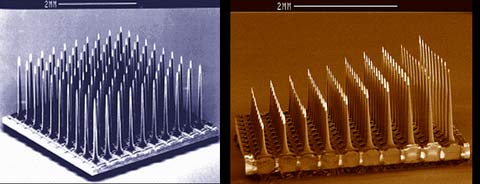Wireless Bionic Arm Would Feel Real

Work on artificial arms that would be controlled by the human mind is ramping up thanks to a helping financial hand from the Defense Advanced Research Projects Agency.
DARPA announced in February that it would pour $55 million into a prosthetic arm research project to be led by Johns Hopkins University’s Applied Physics Laboratory. The work will be spread among more than two dozen institutions.
Today, the University of Utah announced a $10 million contract, as part of the overall project, to develop a "peripheral nerve interface." The implanted device would relay nerve impulses wirelessly from what’s left of a limb to a computer worn on the person’s belt. From there, the signals would be routed to a bionic arm and back to the remainder of the amputated arm, where they would then flow naturally back to the brain.
Researchers at the university have already developed a pill-sized array with 100 tiny electrodes. Now they’ll seek to improve on the arrays so they can be implanted in up to four of the major nerves in a patient’s residual arm. Each electrode would communicate with a small number of fibers within a nerve.
"Imagine an artificial arm that moves naturally in response to your thoughts, that allows you to feel both the outside world and your own movements, and that is as strong and graceful as an intact, biological limb," said bioengineer Greg Clark, the University of Utah's principal investigator on the project. "That's what our researchers, teaming with others around the world, are setting out to achieve.”
Over the next four years, other scientists will build a next-generation mechanical arm designed to work like the real thing.
Existing prosthetic limbs can typically manage just one movement at a time.
Get the world’s most fascinating discoveries delivered straight to your inbox.
"The new arm will take the signals that go to all the different arm muscles at once, and all the person has to do is think about natural movement and the arm will respond in a natural way,” Clark said. “We're basically listening in on what the nervous system would be telling the natural arm, and translating that into signals that will move the artificial arm in the same way."
Robert is an independent health and science journalist and writer based in Phoenix, Arizona. He is a former editor-in-chief of Live Science with over 20 years of experience as a reporter and editor. He has worked on websites such as Space.com and Tom's Guide, and is a contributor on Medium, covering how we age and how to optimize the mind and body through time. He has a journalism degree from Humboldt State University in California.



